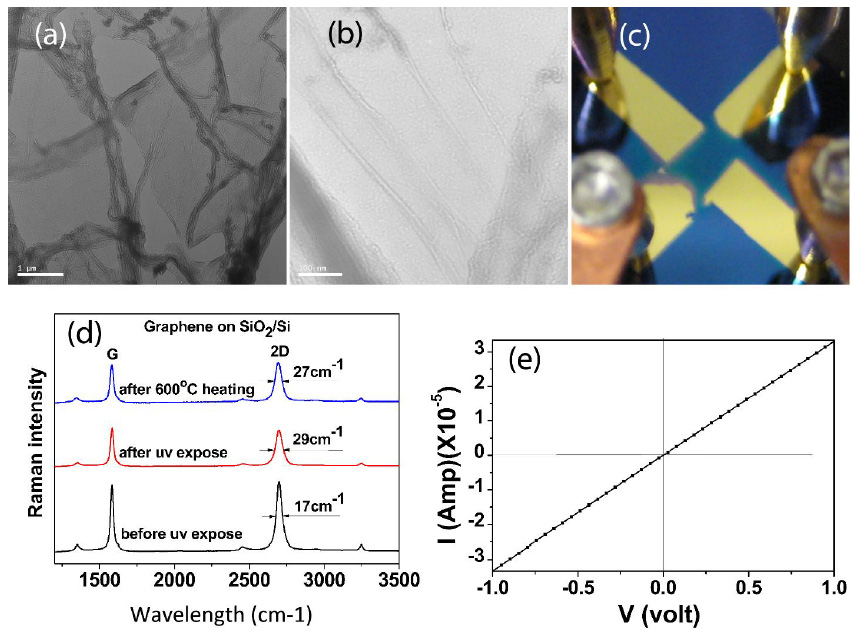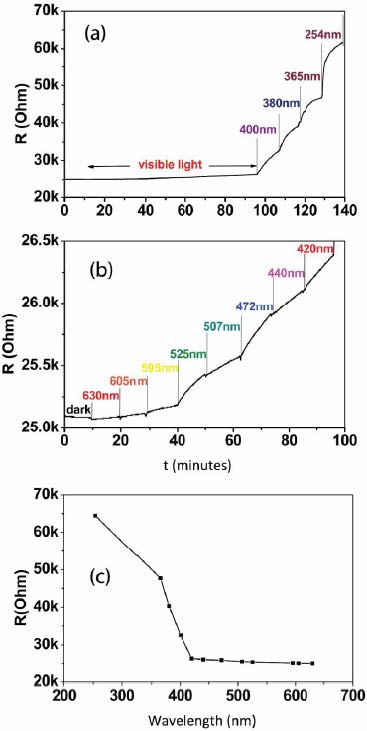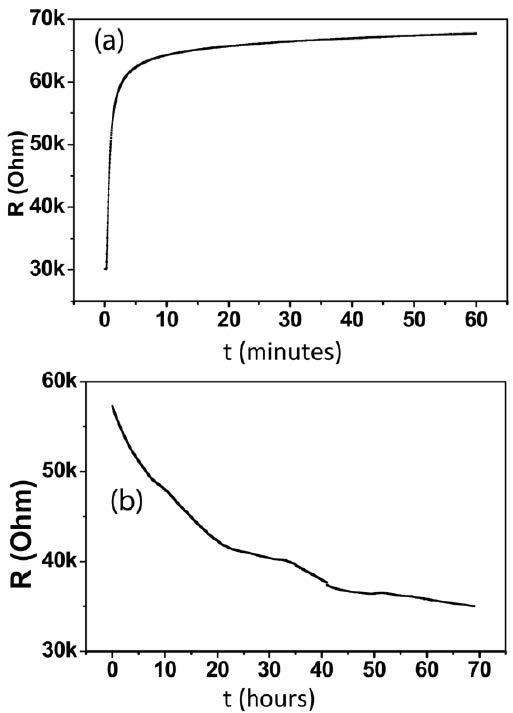1. Introduction
Graphene, a truly two-dimensional material with a carbon honey-comb planar structure, has attracted tremendous attention since its first realization by exfoliation in 2004 largely due to its unique electronic properties that makes it a promising candidate in next generation electronic devices and sensors [1,2,3,4,5,6,7]. In graphene, all the carbon atoms are surface atoms, which is different from bulk materials where the number of surface atoms is only a small fraction of the total. As a result, all carbon atoms in graphene are exposed to the environment, which can make the electronic properties very sensitive to its surroundings. Many studies have been reported on the effect of adsorbates on the electronic transport properties of graphene [8,9,10,11,12,13,14,15]. Hydrogenation and oxidation, which are accompanied by a sp2 to sp3 transition of the carbon bond, can convert graphene from a conductor to an insulator [16,17,18,19,20]. Chemical doping using NO2 adsorbates can cause slight but detectable changes in the electronic properties [11]. Physisorption of H2, O2, N2, CO, CO2, and NH3 does not significantly affect the electronic properties [12,13]. One of the main goals of these studies was to find a reliable way of changing graphene from a conductor to semiconductor, for electronic applications. The effects of H2O molecules, one of the main components of the environment, on the electronic properties of graphene have also been reported. Yavari et al. observed a reduction in the conductivity of chemical vapor deposition (CVD) grown graphene in different humidity environments, and proposed that a band gap of up to 0.2 eV was opened [14]. Theoretical studies found that H2O molecules play the role of electron acceptor when adsorbed on graphene, and this effect is enhanced by a silicon dioxide substrate [15]. Recently, there have been reports [21,22,23,24] suggesting that adatoms on graphene can be ionized by applying a gate voltage, and the ionization causes a sharp change in the electrostatic potential.
In this paper, we report that the resistance of a CVD-grown graphene film, which is transferred from deionized (DI) water to an SiO2 substrate, increases as the wavelength of light incident on the film decreases from the visible to ultraviolet (UV). We attribute this phenomenon to photo dissociation of adsorbates such as H2O between the graphene film and SiO2 substrate that are adsorbed at grain boundaries in the film. Our results may be useful in electronic devices that utilize large-area CVD-grown graphene films. For example, in transparent conducting windows for flat panel displays, it may be desirable to have the conductivity of the CVD film constant while it is exposed to light, which may be accomplished by removing adsorbates from the interface. In addition, our results may provide a convenient method for tuning the resistivity of CVD-grown graphene films by varying the wavelength of incident light, and sensing the presence of interfacial adsorbates at grain boundaries and other defects.
2. Materials and Methods
Graphene was grown on a 25 µm thick copper foil by the CVD method in a tube furnace. The growth conditions were temperature of 950 °C, flow rates of 50 sccm for H2 and 100 sccm for CH4, and total pressure of 30 Torr for 10 minutes. The copper foil was placed on a flat quartz block. After growth and cool down, the copper foil was placed in a 1 M Fe(NO3)3 solution with the growth side facing up. After the copper was etched, the graphene floated to the surface and was then transferred to DI water for cleaning purposes. Finally, the graphene was transferred from the DI water onto a SiO2/Si substrate consisting of a highly p-doped Si wafer covered with a thermally grown 300 nm SiO2 layer. The sample was not back gated.
Four electrodes were made on the sample by thermally evaporating 10 nm of Ti, 200 nm of Ag and 30 nm of Au consecutively on the sample at a pressure of 5 × 10−6 torr. The distance between opposite electrodes is approximately 3 mm. Four gold-coated copper probes were used to contact the electrodes. The I-V characteristics of the sample were measured using a Keithley 485 Picoameter and Keithley 487 Voltage Source programmed with Labview. The micro-Raman system used was a Nicolet Almega XR spectrometer with a spot size of 0.6 μm2, a laser wavelength and power of 532 nm and 6 mW, respectively, and a spectral resolution of 2 cm−1.
We used the above device structure to investigate the resistance of the graphene sample as a function of time while under exposure to light of different wavelengths. In the measurements, the output voltage between two of the electrodes is fixed at 1 V, while the current is recorded every 2 seconds as the sample is exposed to light. The light sources are light-emitting diodes (LEDs) of different peak wavelengths (630-380 nm) or a Xenon gas lamp (365 and 254 nm with filters) at a distance of 2 cm from the sample. The exposures are made in the following order: red (630 nm), orange (605 nm), yellow (595 nm), green (525 nm), aqua (507 nm), blue (472 nm), pink (440 nm), violet (420 nm) and UV (400 nm, 380 nm, 365 nm, and 254 nm). The exposures at different wavelengths are made by removing one light source from the enclosure and replacing it with another one. The intensity of the light at each wavelength is carefully calibrated and monitored by an optometer to ensure that light at each wavelength has the same incident intensity of 2 mW/cm2.
3. Results and Discussion
Transmission electron microscopy (TEM) images of the CVD-grown graphene films were obtained using copper grids, as shown in Figures 1(a) and 1(b); the films have typical folds and few amorphous particles. A close view of the sample holder with four gold-coated copper probes for electrical contact is shown in Figure 1(c). Micro-Raman spectroscopy at different steps of the process was carried out. Graphene grew only on the side of the copper foil facing the gases as determined using Raman spectroscopy. No Raman signal corresponding to carbon was observed on the lower surface of the foil. After transfer to the SiO2 substrate, as shown in Figure 1(d), the 17 cm−1 full-width-at-half-maximum (FWHM) of the 2D Raman peak at about 2700 cm−1 demonstrates that the sample is monolayer graphene. The Raman spectrum of low-defect density monolayer graphene is also characterized by a ratio between the 2D and G peaks of about 4. In our samples, the ratio is about 1. We attribute this to defects in the film. The Raman spectra in Figure 1 show a slight D peak at about 1330 cm−1 that is due to defects. Figure 1(e) shows the I-V characteristics of the graphene device and demonstrates that the device has good Ohmic contacts.
We observe that the smaller the wavelength of incident light, the greater the saturation value of the sample’s resistance, as shown in Figure 2. The experiments were carried out by changing the wavelength of the incident light from longer to shorter. The total exposure time at each wavelength was 10 minutes. As shown in Figure 2(a), in the visible light range, incident light only slightly increases the resistance of the sample. When the incident light is in the UV range (starting from about 400 nm), the saturation resistance of the sample increases to a higher value. The largest saturation resistance observed is about 2.5 times the value before light exposure. The small abrupt drop in resistance each time the light source is replaced every 10 minutes observed in Figure 2(b) is due to the fact that the I-V measurement is continuous. During the time period during which the light source is replaced (usually 20-30 seconds), the resistance of the sample decays slightly, although the drop is insignificant in comparison to the saturation value of resistance resulting from the subsequent exposure.
The resistance vs. time curve of the sample shown in Figure 3(a) shows a typical exponential increase with a time constant of several minutes; in this case, 1.6 minutes for 254 nm. When the incident light is turned off, the resistance decays exponentially with a much longer time constant of tens of hours; in this case, 21 hours after 254 nm irradiation, as shown in Figure 3(b). The fluctuations in Figure 3(b) are attributed to uncontrollable humidity changes in the environment during the long decay [15]. After decay, the increase in resistance upon irradiation is repeatable.
The increase in resistance vs. time is also observed when the sample is placed in vacuum at 1 × 10−5 Torr and exposed to 254 nm UV light. This implies that the density of H2O and other molecules in the air is not a significant parameter in the observed phenomenon. Micro-Raman spectroscopy was carried out after the sample was irradiated by 254 nm UV light. No significant changes of the D peak in the Raman spectrum was observed. This excludes the possibility of defect creation or hydrogenation of the graphene sample induced by light exposure, as the appearance of the D peak is an indicator of defects and hydrogenation of graphene [18]. Furthermore, we did not observe a G peak shift, as known in the case of graphene oxidation [25].
We cleaned samples of CVD-grown films on SiO2 substrates by heating them at 600 °C in a vacuum of 1 × 10−7 Torr for 10 minutes to remove residual adsorbates such as H2O molecules. After cooling the sample to room temperature (RT), it was removed from the vacuum chamber and micro-Raman spectra were measured in air, as shown in Figure 1(d). The Raman data show that heating did not introduce defects into the sample. We then carried out the electrical measurements under irradiation at 254 nm on cleaned samples that had been subsequently stored in air at RT and a relative humidity of 45% for two days, and did not observe an increase in resistance. We also carried out the same experiments on monolayer graphene mechanically exfoliated from highly oriented pyrolytic graphite (HOPG) onto an SiO2 substrate at RT and a relative humidity of 45%, and did not observe an increase in resistance with light exposure. In addition, we carried out electrical measurements under irradiation at 254 nm on CVD-grown films transferred onto mica and glass substrates, and observed an increase in resistance.
Based on these experimental observations, we conclude the following. First, gases in the atmosphere do not directly influence the light induced resistance increase since the effect is observed both in air and vacuum. Second, both CVD-grown and mechanically exfoliated graphene samples have layer(s) of H2O molecules at the interface between the graphene and SiO2 substrate from prior exposure of the substrate to air [26]. However, a significant difference between CVD-grown graphene and an exfoliated sample is that the CVD-grown sample is full of defects mainly at grain boundaries [27]. This suggests that the effect is correlated to grain boundaries since the effect is not observed in single-crystal exfoliated graphene but observed in CVD-grown graphene films that contain grain boundaries. Third, CVD-grown graphene has adsorbates on almost all of its grain boundaries [27]. Heating in high vacuum eliminates the effect, which suggests that the effect is due to adsorbates bound on grain boundaries that are desorbed by heating. The specific adsorbates bound at grain boundaries in CVD-grown films are not known [27]. However, since water is used in the etching of the copper foil and transferring of the film to the SiO2 substrate, it may be one of the adsorbates. Since samples of CVD-grown films on SiO2 substrates that are heated in vacuum and then exposed to air for two days do not show the effect, we conclude that gases adsorbed during this exposure are not responsible for the effect. Such gases would be mainly adsorbed above the graphene film since gases typically require temperatures greater than 340 °C to readily intercalate into the graphene/substrate interface [28,29]. In particular, it takes H2O over 70 days at RT to diffuse on the order of 10 µm into the graphene/SiO2 interface [26]. This distance is over two orders of magnitude smaller than our sample dimensions and distance between electrodes. This suggests that the effect is due to adsorbates at the graphene/SiO2 interface.
The increase in saturation resistance with decreasing wavelength suggests that the effect is due to photo-induced processes. It has been reported that photo dissociation of H2O adsorbed between the basal plane of single-crystal graphene and an SiO2 substrate occurs at an incident wavelength that exhibits a maximum intensity between 150 and 200 nm [30]; these authors proposed that the dissociation was also facilitated by -OH silanol groups on the SiO2 surface. In our experiments, a large increase in resistance is observed at about twice the wavelength (400 nm), possibly because the molecules are chemisorbed at grain boundaries and consequently already partially dissociated, requiring less energy to dissociate them further. First principles calculations show that dissociation of H2O adsorbed on defects in graphene occurs at activation energies lower than half of those of bulk water along many reaction pathways [31]. The chemical species that we propose are produced from water molecule dissociation are hydrogen and hydroxyl radicals, similar to the species produced in Ref. [30]. As discussed in Ref. [30], hydrogen and hydroxyl radicals may react with carbon atoms in the graphene lattice producing sp3 bonds that locally distort the lattice. The hydrogen radicals may produce hydrogenation of carbon atoms that has been reported to increase the resistivity of graphene [16,18]. Hydrogenated graphene has been reported to slowly dehydrogenate and return to its original state over a period of hours to days at room temperature [16,18]. The exact recovery mechanism is not well understood, but may involve desorption of hydrogen or recombination of hydrogen and hydroxyl species.
4. Conclusions
In summary, we have observed that the resistance of CVD-grown graphene films transferred onto SiO2 substrates increases as the wavelength of incident light decreases from the visible to UV. We attribute this effect to photo dissociation of interfacial adsorbates at grain boundaries in the film. We propose that a possible adsorbate is H2O, based on the large increase in resistance at 400 nm. This is consistent with reports on the dissociation of interfacial H2O between defect-free graphene and SiO2 occurring at 200 nm, and theoretical predictions that the dissociation energy of H2O adsorbed on defects in graphene is less than half that of bulk water. Our results may be useful in the design of electronic devices that utilize large-area CVD-grown graphene films, and as a method for tuning the resistivity of CVD-grown films and sensing interfacial adsorbates on grain boundaries. We believe additional experiments and computer simulations would help us to better understand the quantum behavior of H2O adsorbed between defects in graphene and the SiO2 substrate.
Acknowledgements
The authors thank Mr. C.L. Chi for taking TEM images of the CVD graphene film, and Dr. T. Cai, J. D. Jones and J. Wahrmund for their helpful discussions. The work was funded in part by the US Air Force Office of Scientific Research (Award No. FA9550-09-1-0367), the National Science Foundation (Award No. CBET-0754821), NSF LASIGMA Project (Award No. EPS-1003897, NSF92010-15-RII-SUBR), NSF OIA-15410795 and the Louisiana Board of Regents, NASA LEQSF-EPS(2014)-RAP-12, DOE (Award No. DE-FE0008382 and DE-FE0011550), LSU HPC allocation and the LONI institute CPU allocation.
Conflict of Interest
The authors declare that there is no conflict of interest regarding the publication of this paper.










 DownLoad:
DownLoad: 







